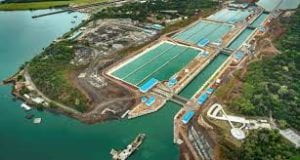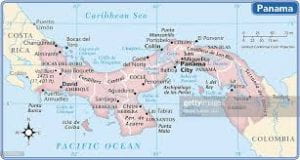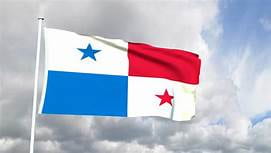My name is Justin I am from North Hampton, New Hampshire. I already wrote a letter to you, but I have some more questions. Are you allowed to visit the volcanos or not? What language is the easiest for you speak? Do you now anyone who works at the Panama Canal? Do you work at the Panama Canal? What is that like? Does your country have traditional food? Do you ever get snow or dos it not snow there because you are so close to the equator? Do you even now what snow is? Have you ever seen the Panama Golden Frog? What kind of house do you live in? Is it close to the ocean or is it not close? What’s your favorite part of living there?




These are amazing questions. I am sure Grandpa Doug can answer some and his friends that still live in Panama can answer as well. When we are home can you tell me about a Golden Frog? I would love to hear what you know about them.
Dad
Hi Justin, It’s pretty cool that you have a interest in Panama and the Canal. There are volcanoes in The volcan area and yes you can visit them. El Valle is a cool area. It is the largest crater on earth that is inhabited by humans. It is also a area the has golden frogs. You can see them often. The like cool and damp locations. As far as the Canal. I worked summer jobs on the Miraflores locks while in high school my job was to take apart the Mules. Mules are used to pull and guide the ships in and out of the chambers. This was a preventative to ensure the equipment was all way working at 100%. I vista Panama about once a month. Let me know I can help in any way. I was born in the Canal Zone
John Hern
That most be a really Coll Sumer job to have.
Thaks for the invice
Yes, you can visit the volcanoes because they are “inactive volcanos,” which means they have not erupted for well over 500 years and possibly will not erupt again. When I was a boyscout, I camped out on one of the famous Panama volcanoes named El Baru. Also, the Panamanian town of El Valle is pronounced “L-VieYay,” and in Spanish this means “The Valley. It is in the bottom of an extinct volcano, and full of beautiful trees, grass, other plants. It is the only place where the famous golden frog lives. I have never seen a golden frog, but one of your Grandpa Doug’s and my good friends, Robert Baker, lives there.
It does not snow in Panama because the temperature ranges from about 70 degrees to about 105 degrees. Many people live in houses that are built on top of heavy posts often made of concrete because it rains daily during part of the year and people don’t want rain water to flood their homes. Most people live within a few miles of the ocean.
Thank you. Can you give me some answers abut these three things?
1. Is the golden frog going to be released back in to the wild soon?
2. Are the volcanos part of a national park in Panama?
3. Are there any national parks in Panama?
Hi Justin! We meet again. I no longer live in Panama, but I do visit there once in a while. I was there last year. I have seen the big volcano that is called El Baru. I have never been up to the top and am not sure if it’s permitted to go down into it.
Snow — I knew what it was, but not what it was like. I saw snow for the first time when I was a junior in college. I didn’t like being cold, but it is beautiful to look at.
Golden Frogs — there are a lot of poison dart frogs in Panama and depending on the area of the country they are different colors. Golden frogs are from the area called El Valle. They are endangered and almost died out because of a fungus. Many US zoos started programs to breed the frogs. When I was a kid we used to catch them. They are pretty small frogs. A few years ago on a visit we went to various areas to take pictures of the different poison dart frogs.
English is my first language, but I used to be able to speak fluent Spanish. I don’t use Spanish much in the States, so I have lost a lot of my ability to speak it. It takes a couple of weeks being surrounded by Spanish-speakers to be comfortable using it.
I don’t know anyone that works for the Panama Canal right now.
My two favorite foods from Panama are empanadas and ceviche.
I have a question about the golden frog . Are the golden frogs dangles to tosh? And you really sol a Panama volcano no far!!!!
Hi Justin,
Your grandfather and I were classmates at Balboa High School, located in what was called the Canal Zone in Panama. To this day, former classmates connect on Facebook to renew friendships and relive their memories of this magnificent country. (That’s how I found out about your blog!) When I lived there, our backyard led to the jungle, and we often saw wild animals sun themselves on the lawn. Can you imagine how exciting that was?
Keep writing your blog, Justin. You never know who might be reading it.
Best wishes,
Miki Garcia
BHS class of 1963
Did my grandpa ingout the school that you and him went to?
Golden frogs are tiny little things with toxic / medicinal / drug secretion in their skin, one of several species in Panama that are useful if you want to make poison arrows or darts. But highly illegal, as they are very endangered. The epidemic of the chitrid fungus has played havoc on them and a number of other amphibian species here. A few miles from where I live there is a rescue mission to keep the species alive in captivity, learn how to cure chitrid infections and see if there might be some sort of vaccine.
I hope that the golden frog dose not go instinct.
I live with dogs and cats in a grungy guy cave sort of house, cinder blocks and zinc roof, in 900 square meters of land which I lazily try to cultivate. It’s dry season so not much produce is forthcoming — mainly just some peppers, spinach and the occasional papaya or star apple. There is a cashew blight and I fear that my tree is a goner. Earlier, the banana blight got almost all of my bananas.
The seasonal winds come howling through my bamboo stand, covering the property with these bamboo leaves that do not compost quickly but eventually do decompose. They do add carbon and substrate to soil that was once bare red clay.
I live with three dogs and one cat named angel
Hi Justin, Great that you have an interest in Panama. The National dish is called Sancocho. It’s a wonderful chicken soup using most of the native root vegetables corn and green plantain. One recipe I have starts with”First you catch a yard chicken.” The native language is Spanish but most Panamanians speak English as well. Golden frogs are best seen in zoos in the USA since they are still not doing well in the wild. The zoo in Asheboro N.C. has a nice display.
Chris Lastinger BHS clas of 65
Can you tell me more about the food?
Hola Justin, I lived in Panama during my youth through my first two years of college. I lived in several different town sites with the last one named Diablo Heights. (Devil Heights). From my bedroom window I could see ships ending or beginning their trip through the canal. We lived about 3 miles from the Pacific Ocean. Growing up in Panama was a wonderful experience…one could swim in the Pacific Ocean and about an hour later go swimming in the Atlantic Ocean.
I saw snow for the first time when I was a college student in North Carolina. I was a junior and loved watching it fall from inside. I did not like the cold at all.
Almost all the Americans learned to speak Spanish and were very good at communicating with the Panamanians. Panama has gorgeous beaches and beautiful mountains.
There are only two seasons, DRY and RAINY. During rainy season, it practically rained every day and dry season it never rained.
Panama has absolutely gorgeous flowers. To name a few there are hibiscus, gardenias, birds of paradise, shrimp plants, red ginger and many varieties of orchids. So many different species.
They did have American in the area known as the Canal Zone which is where the Americans ate a dish called Johnny Marzetti which originated in Ohio and rumor has it that it was brought to Panama by one of the Canal workers who was from Ohio. It became a very popular food and at many gatherings of Zonians today, someone always brings it. Other foods which were typical to the country were: empanadas: a meat filled pastry in the shape of a half moon, ceviche: a dish consisting of raw fish known as corvina that cooked itself in lime juice and served by itself or with s altines, plátano maduro, patacones ( both of these were made with plantain), caramiñoles: made with ground meat and mashed yuca and sancocho: a soup/stew made with chicken and root vegetables. All these foods are absolutely delicious. You should have your grandfather make some of these the next time you get together.
I didn’t answer all your questions because I noticed some of the others already answered them. Good luck with your project!
Dose it snow in panama?
Hello Justin: Your grandfather Doug is very proud of you. Your grandfather is my cousin, his mother great-auntie Lucia was my grandmother’s Edith cousin and we lived in Panama City. When my siblings and I were born we spoke Hakka a Chinese dialect, later learn Spanish and English and when we went to elementary school we learned to read and write.
There are three volcanoes in Panama. Volcan Baru in Chiriqui province with an elevation of 11,398 last eruption around 1550. La Yeguada in Santiago province elevation 4,255 last eruption 1620, and El Valle de Antón in Coclé province elevation 3,888 with a radius of 6 km radius was formed around 1.3 million years ago.
I am familiar with El Valle de Antón when my grandparents Lum and See built a small hotel in 1939 named Hotel Pan-Americano, years later from 1948 to 1951 my parents and my siblings went to live in El Valle de Antón, and my parents had an hectare and with he help of a local young man they planted a vegetable garden with all types of vegetables and fruits and he helped her maintained it. My siblings and I attended school at La Escuela Mixta de El Valle with the locals and native indians and I still communicate with the Muñoz family they were the primary bread makers and delivered the famous ‘michitas’ and ‘viril’ to my aunt and uncle general store, Comisariato Luis. After school we played by the river with the Golden Frogs, we saw tigrillos, wild animals and many insects. We bathed at Chorro de las Mozas also at the hot springs, hiked the hills behind the hotel and surroundings, took care of the Square Trees, but were not allowed to hike La India Dormida, the Sleeping Indian, Flor del Aire, daughter of Urraca, the native indian warrior.
There are many favorite Panamanian foods like Arroz con Pollo (chicken, rice, spices and local vegetables), Sancocho de Pollo, Tamale wrapped in plantain leaves, Tamal de Olla, Ceviche de Corvina, Fried ripe Plantain, Patacón made and fried from green plantain, yuca frita, a tuberous, Torrejas de Maíz and many others.
Since 2013, I was able to reconnect with your grandfather after 50 years when Sam and I became members with the Panama Canal Society and where we meet with the other CUZs. Almost every year I returned to Panama city and visit my other cousins.
That a lot of faks send me more.
i hope your project is going well. I managed to forward your blog to classmates/friends from Panama and the Canal Zone. My initial response to your blog apparently went astray. As a youngster I managed to see several gold frogs when I visited El Valle.
This was sent to me by a classmate and friend of mine from the Canal Zone, Leslie Hendricks, who thought you may want to use the picture as a theme for your Panama project. She took it while visiting El Valle in Panama. if you are not able to view the picture I will send it to your mom.
I know you will do a great job with your project.
Grandpa Doug
Image-1.jpg
Me to I LOVE YOU SOOO MOCH!!!!!!!
I mean I LOVE YOU not me love you
Panama all the way I love Panama My grandpa Doge lives there I want to go to schooll, there